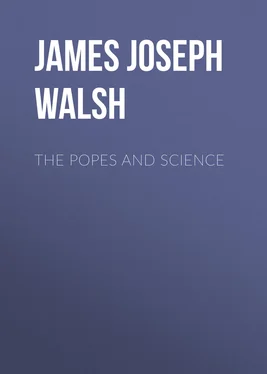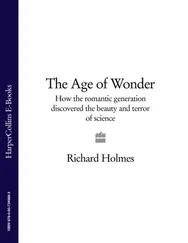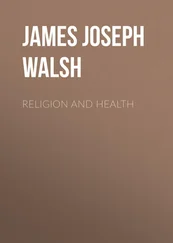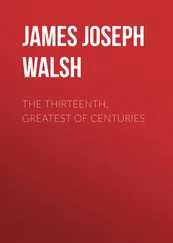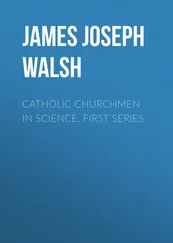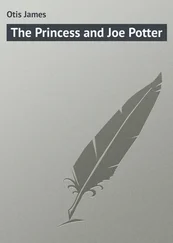James Walsh - The Popes and Science
Здесь есть возможность читать онлайн «James Walsh - The Popes and Science» — ознакомительный отрывок электронной книги совершенно бесплатно, а после прочтения отрывка купить полную версию. В некоторых случаях можно слушать аудио, скачать через торрент в формате fb2 и присутствует краткое содержание. Жанр: foreign_prose, foreign_religion, foreign_antique, на английском языке. Описание произведения, (предисловие) а так же отзывы посетителей доступны на портале библиотеки ЛибКат.
- Название:The Popes and Science
- Автор:
- Жанр:
- Год:неизвестен
- ISBN:нет данных
- Рейтинг книги:4 / 5. Голосов: 1
-
Избранное:Добавить в избранное
- Отзывы:
-
Ваша оценка:
- 80
- 1
- 2
- 3
- 4
- 5
The Popes and Science: краткое содержание, описание и аннотация
Предлагаем к чтению аннотацию, описание, краткое содержание или предисловие (зависит от того, что написал сам автор книги «The Popes and Science»). Если вы не нашли необходимую информацию о книге — напишите в комментариях, мы постараемся отыскать её.
The Popes and Science — читать онлайн ознакомительный отрывок
Ниже представлен текст книги, разбитый по страницам. Система сохранения места последней прочитанной страницы, позволяет с удобством читать онлайн бесплатно книгу «The Popes and Science», без необходимости каждый раз заново искать на чём Вы остановились. Поставьте закладку, и сможете в любой момент перейти на страницу, на которой закончили чтение.
Интервал:
Закладка:
[Footnote 4: The original Latin taken from Puschmann runs thus: "De cadaverum sectione facienda in publicis Academiis, utrum constitutio Bonifacii VIII. sectioni humanorum cadaverum adversetur. Singulari dei beneficio medicinae studium in hac civitate (Roma) magnopere floret cujus etiam professores ob eximiam virtutem in remotissimis terrae partibus commendantur. Ipsis sane maxime profuit, quod incidendis mortuis corporibus diligentem operam contulerint, ex qua procul dubio praeclaram artis scientiam, in consultationibus obeundis pro aegrotorum salute praestantiam, morbisque eurandis peritiam consecuti sunt . . . . Porro haec membrorum incisio nullo modo adversatur Bonifacii Institutioni . . . . Ille quidem poenam excommunicationis indicit Pontifici solo remittendam, iis omnibus qui audeant cuiuscumque defuncti corpus exenterare, ac illud membratim vel in frustra immaniter concidere ab ossibus tegumentum carnis excutere. Tamen ex reliquis ejusdem constitutionis partibus clare deprehenditur, hanc poenam illis infligi qui sepulta corpora e tumulis eruentes ipsa nefario scelere in frustra secabant ut alio deferrent, alioque sepulchro collocarent. Quamobrem membrorum incisio minime interdicitur, quae adeo necessaria est medicinae facultatem exercentibus."]
This whole subject of the Supposed Papal Prohibition of Anatomy is typical of a certain form of controversial writing against the Church. A document of some time or other from the Middle Ages is taken, twisted from its original meaning and set up as a serious stumbling block to the development of science or education in some way. It is quoted confidently by some one without much authority. Others who are glad of the opportunity to have such an objection to urge against the Papacy, take it up eagerly, do not look it up in the original, absolutely fail to consider the circumstances in which it was issued, and then spread it broadcast. Of course it is accepted by unthinking readers, whose prejudices lead them to believe that this is what was to be expected anyhow. It maybe that history, as is the case in anatomy, absolutely contradicts the assertion. That makes no difference. History is ignored and treatises are written showing how much science would have developed only for Papal opposition, by people who know nothing at all about the real story of the development of science. The real history of anatomy, showing very clearly how much was done for the science by the Popes and ecclesiastics, will be told in the following chapters.
THE STORY OF ANATOMY DOWN TO THE RENAISSANCE
We have seen that the supposed prohibition of anatomy by the Popes has no existence in reality. In spite of this fact, which it was easy for anyone to ascertain who wished to consult the documents asserted to forbid, a number of historical writers have insisted on finding religious or ecclesiastical, or theological, opposition to anatomical studies. Professor White has been most emphatic in his assertions in this regard. He admits that the supposed bull of prohibition had quite a different purport, yet he still continued to assert its connection with the failure of anatomy to develop during the Middle Ages. This presumed failure of anatomy during the Middle Ages is a myth. It continues to secure credence only in the minds of those who know nothing of the history of medical science during the thirteenth, fourteenth, and fifteenth centuries and who have not consulted the serious histories of medicine that treat of this time, but flourishes vigorously in the minds of those who have a definite purpose in making out a story of theological or Church opposition to science in general.
To counteract the false impression that has gained such wide acceptance in this matter, it has seemed advisable, in order to settle the question definitely once and for all, to trace the history of anatomical science from its beginning in the Middle Ages down to modern times. It will not be hard to show that there was a constant development and an unfailing interest in this subject. This can be understood even more clearly from the story of the development of surgery in the Middle Ages and its relations to anatomy than from the history of anatomy itself. As is well known, materials with regard to practical and applied science interest men more at all times, and documents with regard to them are more likely to be preserved, and so the history of surgery is very full, while the history of anatomy may prove not quite so satisfactory. It is true of all sciences, that there are periods when they have much less attraction than at other times, and the success of investigators and original workers is not always the same. As in nearly everything else, the real advances in all science come when genius makes its mark, and not merely because a large number of men happen to be interested in the subject. This will be found as true in anatomy as in other sciences, and so there are periods when not much is doing, but nowhere is there a trace of ecclesiastical opposition to account for these variations of interest.
There is no doubt at all that there was much popular opposition to the practice of dissection in the Middle Ages; that has existed at all times in the world's history. It was very pronounced among the old Pagans in Rome as well as in Greece, and it prevented anatomical study to a very great degree. It continued to exist in modern times until almost the present generation. Indeed, it has not yet entirely disappeared, as any physician who has tried to secure autopsies on interesting cases knows very well. The New York Academy of Medicine is only a little over a half century old, and yet nearly every one of its early presidents had thrilling experiences in body-snatching as a young man, because no proper provision for the supplying of anatomical material had as yet been made by law, and bodies had to be obtained. The feeling of objection to having the bodies of friends anatomized is natural and not due to religion. It exists quite as strongly among the ignorant who have no religion as among the religiously inclined. It has not disappeared among the educated classes of our own time, religious or irreligious. If this is borne in mind, the history of the development of anatomy will be easier to understand.
The first definite evidence in modern history for the existence of the practice of dissection is a famous law of the German Emperor, Frederick II., from the first half of the thirteenth century. This law was promulgated for the two Sicilies, that is, for Southern Italy and Sicily proper, very probably in the year 1240. It has often been vaguely referred to, but its actual significance can only be understood from the terms of the law itself, which has been literally translated by Von Töply in his Studien Zur Geschichte der Anatomie in Im Mittelalter. [Footnote 5]
[Footnote 5: Deuticke Leipzig und Wien, 1893]
The paragraph with regard to dissection runs as follows:
"As an enactment that will surely prove beneficial to health, we decree that no surgeon will be allowed to practice, in case he has not a written testimonial, which he must present to the teachers in the medical faculty, that he has for at least a year applied himself to that department of medicine which is concerned with the teaching and practice of surgery, and that he has, above all, learned the anatomy of the human body in this manner, and that he is fully competent in this department of medicine, without which neither surgery can be undertaken with success nor sufferers cured." [Footnote 6]
[Footnote 6: The complete text of this law, which is a marvelous anticipation of all our efforts for the regulation of the practice of medicine down even to the present day, will be found in the appendix.]
Such a regulation, as pointed out by Professor Pilcher in an article on the early history of dissection, [Footnote 7] and as we know by modern experience, does not come into force as a rule before the actual practice of what is prescribed, has been for some time the custom and its usefulness proved by the results attained. It seems very probable, then, that even at this early day the Emperor Frederick was only making into a law what had been at least a custom before this time. Lest anyone should think that this is a far-fetched assumption, certain other paragraphs of this law, which show very definitely the high degree to which the development of medical teaching had reached, must be recalled. Frederick declared that medicine could only be learned if there was a proper groundwork of logic. Only after three years devoted to logic, then, under which term is included the grammar and philosophy of an ordinary undergraduate course, could a man take up the study of medicine. After three years devoted to medicine, to which it is again specifically declared another year must be added if surgery were to be practiced, a man might be given his degree in medicine, but must spend a subsequent full year in the practical study of medicine under the supervision of an experienced physician.
Читать дальшеИнтервал:
Закладка:
Похожие книги на «The Popes and Science»
Представляем Вашему вниманию похожие книги на «The Popes and Science» списком для выбора. Мы отобрали схожую по названию и смыслу литературу в надежде предоставить читателям больше вариантов отыскать новые, интересные, ещё непрочитанные произведения.
Обсуждение, отзывы о книге «The Popes and Science» и просто собственные мнения читателей. Оставьте ваши комментарии, напишите, что Вы думаете о произведении, его смысле или главных героях. Укажите что конкретно понравилось, а что нет, и почему Вы так считаете.
